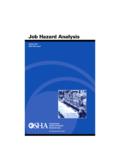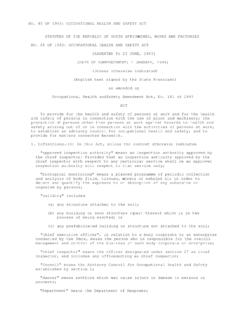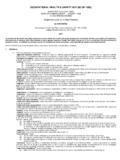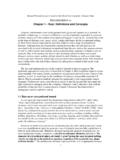Transcription of OCCUPATIONAL HEALTH & SAFETY MANAGEMENT
1 1 | P a g e Targeting OCCUPATIONAL HEALTH and SAFETY Introduction OCCUPATIONAL HEALTH and SAFETY (OHS) MANAGEMENT protects the SAFETY , HEALTH , and welfare of people at the workplace. In 1950, the first session of the joint International Labour Organization (ILO) and the World HEALTH Organization (WHO) Committee on OCCUPATIONAL HEALTH adopted a definition of OCCUPATIONAL HEALTH . The definition was subsequently revised in 1995 and states: OCCUPATIONAL HEALTH should aim at the promotion and maintenance of the highest degree of physical, mental and social well-being of workers in all occupations; the prevention amongst workers of departures from HEALTH caused by This guidance note was prepared by Josefina Doumbia (Principal Environmental Specialist, CESI).
2 Peer reviewers included Adriana Triana (Environmental Specialist, CESI) and Mauricio Athie (Senior Environmental Specialist, CESI). Additional comments and contributions were provided by Bilal Rahil (Senior Manager, CESI), Carlos Arias (Senior Environmental Specialist, CESPQ), Johanna van Tilburg (Senior Counsel, LEGES), and Robert Gerrits (Senior Social Development Specialist, CESI). Editorial assistance was provided by Stan Wanat (Consultant), Juliette Guantai (Program Assistant, ENV) and James Cantrell (Communication Analyst, ENV).
3 The task team leaders for this product are Kulsum Ahmed (Lead Environment Specialist, ENV) and Helena Naber (Environmental Economist, ENV). The product was prepared under the guidance of the following World Bank Group MANAGEMENT : James Warren Evans / Mary Barton-Dock (Directors, Environment Department, World Bank), Bilal Rahill (Senior Manager, IFC), and Frank Lysy / Ravi Vish (Director, MIGA). their working conditions; the protection of workers in their employment from risks resulting from factors adverse to HEALTH ; the placing and maintenance of the worker in an OCCUPATIONAL environment adapted to his physiological and psychological capabilities and, to summarize: the adaptation of work to man and of each man to his job.
4 (Guidotti 2011, 5) All OCCUPATIONAL HEALTH and SAFETY programs aim to foster a safe work environment, including the protection of employers, suppliers, customers, family members, nearby communities, and other members of the public who could be affected by a company s operations. Such programs draw on disciplines such as OCCUPATIONAL medicine, OCCUPATIONAL or industrial hygiene, public HEALTH , SAFETY engineering, chemistry, HEALTH physics, ergonomics, toxicology, epidemiology, and environmental HEALTH .
5 Description and Application of Targeting OCCUPATIONAL HEALTH and SAFETY Typical OCCUPATIONAL HEALTH and SAFETY risks common to the industrial sectors may be categorized as physical, chemical, ergonomic, and biological risks. Slips, trips, falls, noise, and vibration are examples of physical risks. Fires, explosions, leaks, spills, and exposure to gases, vapors, mists, dust, and fumes are common chemical risks. Muscular-skeletal problems resulting from repetitive activities such as lifting and carrying, or from spending long periods in one single position such as sitting at desks and working with computers, are typical ergonomic risks.
6 Lastly, 2 | P a g e exposure to bacteria, viruses, biogenic toxins, and allergens is characteristic of biological risks. To address OCCUPATIONAL HEALTH and SAFETY , a business should identify the workplace hazards (see Appendix, page 10). A hazard refers to a circumstance that has the potential to cause harm. It may indicate a physical situation or it may indicate the omission of necessary preventative measures. An example of a physical situation would be exposure to equipment with sharp edges that could cause lacerations, while an example of an omission would be the failure to provide a guard to prevent injury from the sharp edges on the equipment.
7 Modern OCCUPATIONAL HEALTH and SAFETY legislation usually demands that a risk assessment be carried out prior to making an intervention. Risk MANAGEMENT requires risk to be managed to a level that is as low as is reasonably practical. This assessment should detect the hazards, identify all affected by the hazards, evaluate the risk, and offer and prioritize appropriate control measures. The evaluation of risk is based on the likelihood or probability of the harm being realized and the severity of the consequences.
8 This can be expressed mathematically as a quantitative assessment by assigning integers to denote low, medium, or high likelihood, and assigning integers to indicate the severity of the consequences. The integer assigned for likelihood and the one assigned for severity can be multiplied together to obtain a risk factor. Risk can also be evaluated qualitatively by describing the circumstance in which the harm could arise. Newly introduced controls should lower risk by one level (for example, from high to medium or from medium to low).
9 Risk increases as the seriousness of resulting harm increases, and as the likelihood increases that Box 1. Typical Risk-Control Hierarchy Avoid the risk this is ideal, but not always attainable. Replace the dangerous with the less dangerous for example, replace hazardous materials with safer alternatives. Prioritize the risk focus attention on the greater risks, including those where the public is involved. Control hazards at their source deal with the hazard directly, do not use a secondary control; for example, control noise by repairing or maintaining the machine, not by using hearing protectors.
10 Adapt work to individuals abilities for example, use stronger people for tasks demanding strength. Upgrade work equipment as technology improves newer equipment may be marked to show that it meets tougher SAFETY standards. Implement a coherent control policy ensure that the specific risk control does not cause a disproportionate problem elsewhere; for example, do not solve the problem of a noisy machine by relocating it. Ensure that collective measures have priority over individual measures for example, it is better to provide a SAFETY roof rather than to rely on individual measures such as hard hats.
















